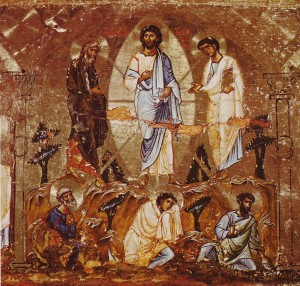 A vast range of difficulties regarding the contested Pauline epistle to the Colossians[1] have long plagued new testament scholars by putting forth a fragmentary constellation of ideas that permits us to “see through a mirror dimly”, to use a Pauline metaphor, into the occasion for the letter and to identify or to categorize Paul’s presumed opponents. In scholarship since the seminal work of Francis and Meeks[2] which challenged the validity of the dominant views of the period (e.g. Käsemann’s theory of Gnostic origins[3]), the current prevailing view seems to be that the “philosophy and empty deceit” (2:8)[4] being taught or practiced in Colossae could most adequately be understood as Jewish apocalyptic mysticism[5].
A vast range of difficulties regarding the contested Pauline epistle to the Colossians[1] have long plagued new testament scholars by putting forth a fragmentary constellation of ideas that permits us to “see through a mirror dimly”, to use a Pauline metaphor, into the occasion for the letter and to identify or to categorize Paul’s presumed opponents. In scholarship since the seminal work of Francis and Meeks[2] which challenged the validity of the dominant views of the period (e.g. Käsemann’s theory of Gnostic origins[3]), the current prevailing view seems to be that the “philosophy and empty deceit” (2:8)[4] being taught or practiced in Colossae could most adequately be understood as Jewish apocalyptic mysticism[5].
Though this may be the case, one quickly becomes conscious of the terminological and conceptual quandary when attempting to enter the conversation of how one categorizes religious or cultic phenomena in ancient texts. Scholarship in general has shown that many attempts to categorize early Jewish or Christian sources by a strict attribution and maintenance of specific genre labels can be problematic. Scholars who point out the conflation of certain genres such as “apocalyptic”, “mystical” and “Sapiential” that may have traditionally been applied individually is needed to bring about a more satisfactory and robust understanding of what is actually going on in any said text[6].
Similar kinds of questions arise when facing the difficulties in attempting to reconstruct what, or identify whom, Paul was actually reacting to on the ground in Colossae. For example, is it has been rightly questioned whether or not one can speak of “false teachers” at Colossae[7] or the existence of an actual “Colossian heresy”, as if there had been some sort of formal “Christian orthodoxy” that could be spoken of at this time[8]. Dunn states further “This is true to such a degree that if one persists with the idea of ‘orthodoxy,’ it would be hard to deny that some of the forms of earliest ‘Christianity’ would be better designated as ‘heresy,’ at least as judged by the subsequent course of theology.”[9] The present study attempts to demonstrate precisely this point.
In attempting to identity the opponents in Colossae as “Jewish Mystics” one might be faced with the historical question of how to characterize Paul’s own views. Using the appellation “Jewish Apocalyptic Mystics” for Paul’s opponents may reflect a presupposition and an inadequate characterization of Paul as the defender of a not-yet- invented Christian orthodoxy. This is of course not to say that his opponents are no longer to be understood as “Jewish Apocalyptic Mystics” themselves, only rather that after an analysis of Paul’s own theological convictions as demonstrated in the epistle to the Colossians, one might find that he himself may be more amply situated in the category of “Jewish Apocalyptic Mystic” than even his opponents. If once the evidence from the epistle is treated fairly and these conclusions can be demonstrated, we may further conclude that the occasion of the epistle when depicted as “Paul’s defense of ‘Christianity’ versus the Jewish Mystics” may be unfavorable or inadequate. Rather it may be best to describe the scenario as “Rival Jewish Mysticisms in Colossae”; Paul’s own Mysticism versus that of his opponents’.
To approach the question of whether situating Paul may rightly be understood in etic terms[10] of Jewish mysticism, it is necessary to provide a functional definition. As DeConick states, the term “identifies a tradition within early Judaism and Christianity centered on the belief that a person directly, immediately and before death can experience the divine, either as a rapture or one solicited by a particular praxis.”[11] Assuming the validity of DeConick’s explanation for the present study, there are many elements of Paul’s teaching in Colossians that would lead us to situate him in the matrix of Jewish Apocalyptic Mysticism. Though this may be the case, due to the limited scope of this study, we will highlight only a few such elements that give us entry to a similar nexus of ideas shared by Paul and Jewish Apocalyptic Mysticism: Jewish Angelomorphic[12] or Theotic[13] traditions, participatory Messianism[14], and realized eschatology.[15] As the present study will attempt to show, the thing that separates Paul from his presumed opponents in Colossae is that all these Jewish expectant or realized traditions can only be experienced or realized through participation “in Messiah”.
[1]Pauline authorship will be assumed in the following paper, although is not detrimental to any arguments therein, assuming one from the “Pauline School” could adequately mirror Paul’s own convictions on the matters contained in the present epistle.
[2] Fred O. Francis and Wayne A. Meeks, Conflict at Colossae: A Problem in the Interpretation of Early Christianity by Selected Modern Authors, rev. ed., Sources for Biblical Study 4 (Philadelphia: Fortress Press, 1975).
[3] Ernst Käsemann, ‘Eine urschristliche Taufliturgie’, Exegetische Versuche Und Besinnungen, 3rd ed. (Göttingen: Vandenhoeck & Ruprecht, 1964), 1:34-51.
[4] The ESV will be the default translation used throughout this paper unless otherwise noted, as may frequently be the case due to many nuanced translations by the present author.
[5] See cf. Clinton Arnold, The Colossian Syncretism: The Interface between Christianity and Folk Belief at Colossae (Grand Rapids, MI: Baker Books, 1996); Jarl E Fossum, “The Image of the Invisible God: Colossians 1:15-18a in the Light of Jewish Mysticism and Gnosticism” in The Image of the Invisible God: Essays on the Influence of Jewish Mysticism on Early Christology (NTEOA 30; Freiburg, Schweiz: Universitätsverlag, 1995), 13-39; though Fossum still maintains remaining influence of what might rightly be understood as “proto-Gnosticism”; Christopher Rowland and Christopher R. A. Morray-Jones, The Mystery of God: Early Jewish Mysticism and the New Testament (Leiden: Brill, 2009), 156-65; Thomas J. Sappington, Revelation and Redemption at Colossae (JSNTS; Sheffield: JSOT Press, 1991); Ian K.Smith, Heavenly Perspective: A Study of the Apostle Paul’s Response to a Jewish Mystical Movement at Colossae (Library of New Testament Studies; London: T & T Clark, 2006); Loren Stuckenbruck, Angel Veneration and Christology: A Study in Early Judaism and in the Christology of the Apocalypse of John (WUNT 70; Tübingen: J.C.B. Mohr, 1995).
[6] Cf. John Collins, Seers, Sybils, and Sages in Hellenistic-Roman Judaism (Supplements to the Journal for the Study of Judaism 54; Leiden: Brill, 1997), 317-385; Grant Macaskill, Revealed Wisdom and Inaugurated Eschatology in Ancient Judaism and Early Christianity (Leiden: Brill, 2007); Smith, Heavenly Perspective; Daniel R. Streett, “Apocalyptic Wisdom in the Epistle to the Colossians” (Unpublished Manuscript; Yale University, 2002).
[7] Cf. Morna D. Hooker, “Were there False Teachers in Colossae?” in From Adam to Christ: Essays on Paul (Cambridge: Cambridge University Press, 1990), 121-36.
[8] Cf. James D. G. Dunn, The Epistles to the Colossians and to Philemon: A Commentary on the Greek Text (Grand Rapids, Mich: William B. Eerdmans Pub, 1996), 24-26.
[9] Ibid., 24. See also as cited by Dunn: Walter Bauer, Robert A. Kraft, and Gerhard Krodel, Orthodoxy and Heresy in Earliest Christianity (Philadelphia: Fortress Press, 1971).
[10] “So ‘mysticism’ is an etic term, a modern typology, contemporary analytic vocabulary that we are imposing on the ancients in order to investigate their religiosity. It serves the modern scholar heuristically as a taxonomy, aiding our engagement in historical investigation and research.” Quote taken from April D. DeConick, “What is Early Jewish and Christian Mysticism” in Paradise Now: Essays on Early Jewish and Christian Mysticism (Edited by April D. DeConick; Atlanta: Society of Biblical Literature, 2006), 2.
[11] Ibid., 2.
[12] “Angelomorphism” is to function in the following study as a soteriological category as articulated in works such as Charles A. Gieschen, Angelomorphic Christology: Antecedents and Early Evidence (Leiden: Brill, 1998); Crispin Fletcher-Louis, All the Glory of Adam: Liturgical Anthropology in the Dead Sea Scrolls (Studies on the Texts of the Desert of Judah 42; Leiden: Brill, 2002); Luke-Acts: Angels, Christology, and Soteriology, (WUNT 94; Tübingen: Mohr Siebeck, 1997); “The Worship of Divine Humanity as God’s Image and the Worship of Jesus” in The Jewish Roots of Christological Monotheism: Papers from the St. Andrews Conference on the Historical Origins of the Worship of Jesus. (Edited by C. C. Newman, J. R. Davila and G. S. Lewis; Supplements to the Journal for the Study of Judaism 63; Leiden: Brill, 1999), 112-28.
[13] “Theotic” referring categorically to soteriological traditions that may be best described by the adjectival form of the term “Theosis” as later frequently employed by the Greek Church fathers. It remains to be thoroughly argued that the idea is conceptually rooted well within the context of Second Temple Judaism, yet in the limited scope of this study, an ambitious yet truncated attempt will be made. “Theotic” in the present study originates from a shared semantic constellation of similar terms such as Theosis, Christosis, Theoformity or Christoformity. Cf. Ben C. Blackwell, Christosis: Pauline Soteriology in Light of Deification in Irenaeus and Cyril of Alexandria (Ph.D. diss., University of Durham, 2010); “Deification and Colossians 2:10” (paper presented at the annual meeting of the SBL; Atlanta, Ga., November 22, 2010); Gregory Glazov, “Theosis, Judaism, and Old Testament Anthropology” in Theosis: Deification in Christian Theology (ed. S. Finlan and V. Kharlamov; PTMS; Eugene: Pickwick Publications, 2006), 16-31; Stephen Finlan, “Can We Speak of Theosis in Paul?” in Partakers of the Divine of the Nature: The History and Development of Deification in the Christians Traditions (ed. M. J. Christensen and J. A. Wittung; Grand Rapids: Baker Academic, 2007), 68-80.
[14] Though “Participatory Messianism” is the determined terminological denotation in the following study, the realization that other terms such as “Corporate Messianism” or “Messianic Solidarity” could similarly serve to describe the Pauline conceptual framework effectively. The functional nuance of “participation” rather than terms such as “corporate” or “solidarity” is that they seemingly carry an implicit notion of passivity, functioning merely as identity markers. The use of “participatory” stresses the notion of active involvement in not merely the identity of Messiah but in status, woes (or afflictions), and glorification.
[15] “Realized” eschatology is the preferred designation in place of “inaugurated” in this study of Colossians due solely to its frequent reference to the already appropriated or available aspects of deity, heavenly mystery, wisdom, power, glory, etc. This being the case, the framework of Paul’s eschatological thought can certainly still be adequately represented by the idea of “inauguration”. Though the three ideas from Jewish Apocalyptic Mysticism may appear here as separate categories, they share the same matrix of ideas through the overlapping use of many of the same texts that could be described from a number of different terminological and conceptual angles; the present author merely chose three.



